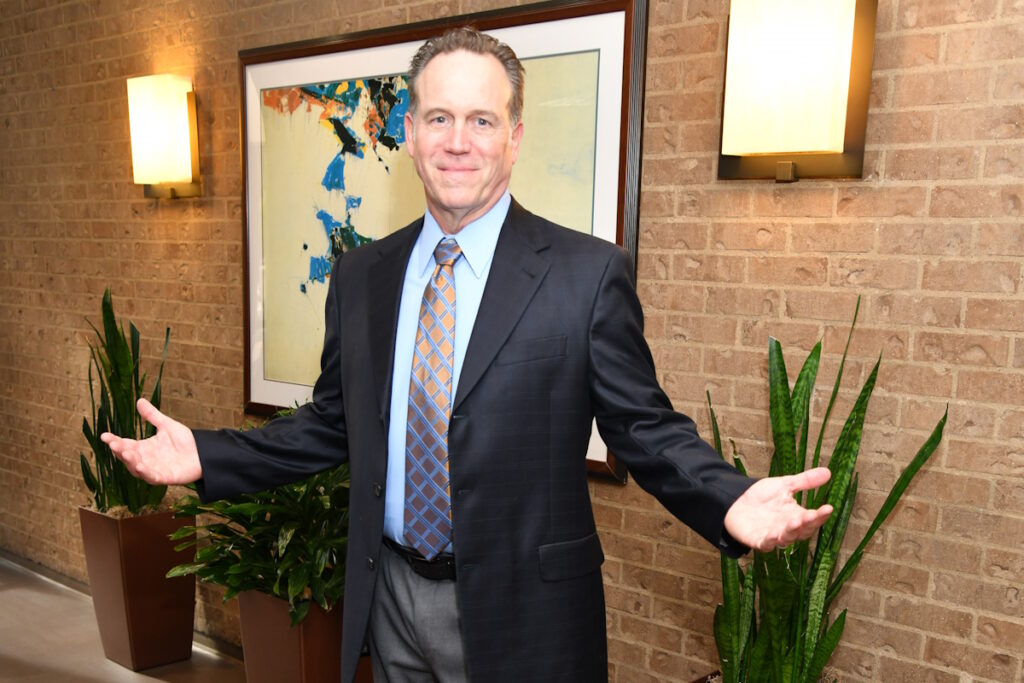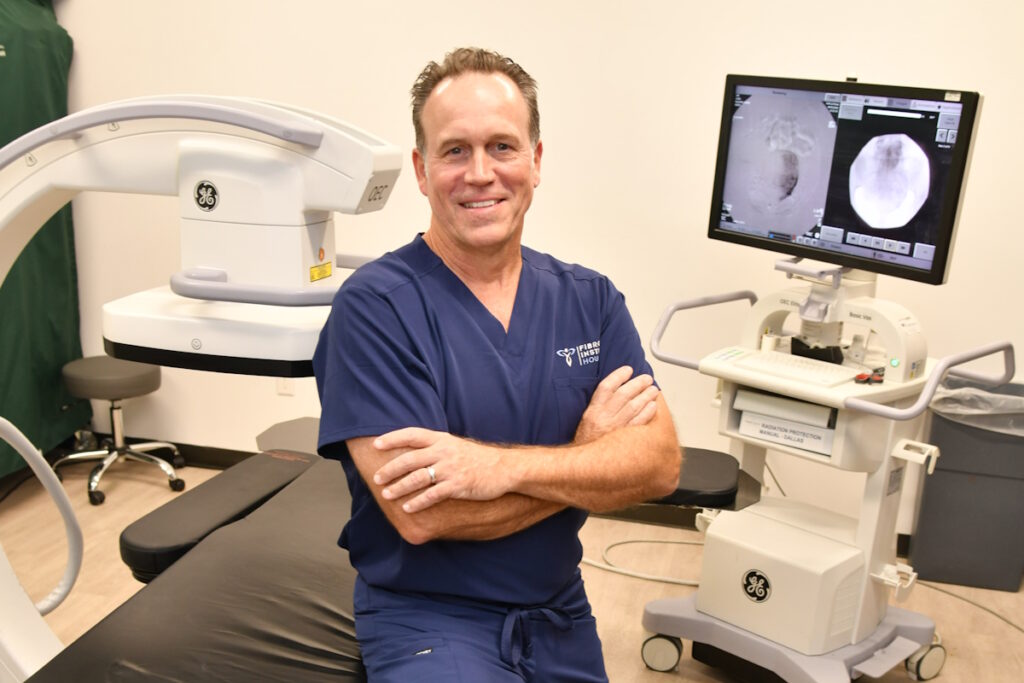Our very own John H. Fischer, MD took a moment between patients recently to share more about the dedicated man behind the scrubs that our loyal patients have come to trust with delivering a seamless, high-quality experience. As a Houston fibroid doctor with over 20 years of experience, Dr. Fischer joined Fibroid Institute Houston in September 2022. He has performed thousands of Uterine Fibroid Embolization (UFE) procedures to help women who have suffered for years and deserve to live without fibroid symptoms. All the while, he preaches patient education and awareness and has developed a reputation as an honest and compassionate healthcare provider.
A third-generation Houstonian, Dr. Fischer is a board-certified radiologist with a certificate of added qualification (CAQ) in interventional radiology. He attended Baylor College of Medicine in Houston and completed his diagnostic radiology residency at the University of Washington in Seattle, where he served as chief resident. He finished his training with an interventional radiology fellowship at UT MD Anderson Cancer Center.
Since 2000, Dr. Fischer has had a noteworthy career in private practice. He performed one of the first UFEs in the Houston market and served as an Associate Professor of Radiology at the Baylor College of Medicine. He is sought after as a speaker, author, and educator on fibroid treatment topics. He also served as primary investigator for one of 10 locations, and the first in the United States selected by the FDA to evaluate new technologies for uterine fibroid treatment. Dr. Fischer is a member of multiple medical societies and serves in leadership roles on committees and boards for hospitals, practices, and organizations.
Please keep reading to learn more about this dedicated Houston fibroid doctor.
Q & A With John H. Fischer, MD of Fibroid Institute Houston
Q: Why did you decide to become a Houston fibroid doctor? What personal and/or professional path brought you here, and how long have you been practicing?
A: For as long as I can remember, I always wanted to be a physician. As a child, I would read anything I could find in encyclopedias (when they were still a thing) related to medicine, anatomy, and the human body. My father began dental school when I began kindergarten. I remember visiting him in his anatomy lab and being fascinated by the cadaver. I watched my father work nights and weekends as a pharmacist to support our family while in dental school. He finished in three years, one year early, and near the top of his class. His work ethic, discipline, and dedication were very influential on me as a child. As a teenager and young adult, I worked in my father’s dental practice for several years, long enough to determine dentistry was not for me. It was then that I decided on a career path in medicine.
Q: What conditions/treatments are your primary focus?
A: I have practiced radiology for 23 years. My focus has been in interventional radiology, but I have always performed diagnostic radiology as well. I believe being a good diagnostic radiologist makes you a better IR. It is hard to know how many total image-guided IR procedures I have performed over the years, but it is likely more than 20,000. I began performing UFE immediately after my fellowship training in 2000, before the procedure became a mainstream treatment option. I performed one of the first UFEs in Houston and have performed about 3,500 UFEs to date. While I enjoy all types of IR cases, UFE has always been my focus and passion.
Q: What is your favorite patient success story, and what happened in that case?
A: I have several special patient success stories. We have had at least 15 women (that we know of) get pregnant and experienced a normal full-term pregnancy after UFE. We have photos of most, and have had them proudly displayed in our office, our “UFE babies.”
We once treated a patient whose fibroids were so large, and bleeding (and anemia) was so severe, that it was preventing her from undergoing a life-saving kidney transplant. After the UFE, her fibroids shrunk, and her bleeding (and anemia) improved to a point where the transplant could be performed safely. She was transplanted three months after the UFE, and she continues to do well to this day.
Lastly, we once successfully treated a fibroid patient who was bleeding so heavily during each menstrual cycle that she had to have monthly blood transfusions. After the UFE, her cycles were normal, and she no longer required transfusions.
Q: As a Houston fibroid doctor, what are some of the biggest challenges you and your team face?
A: Patient awareness and education. Many patients with fibroids are not aware of UFE or other minimally invasive treatment options.
Q: What about your practice makes you and your team different from similar practices?
A:
Experience: There is very little I have not seen or done when it comes to UFE. I have taught the procedure to IR fellows in training for over 20 years.
Dedication: Our commitment is to the patient. We always do what is best for the patient. Nothing is more important than our patient’s safety and satisfaction.
Detail: Our attention to detail. We can’t do the big things well without doing the little things well.
Focus: Our focus is 100% on fibroids and fibroid treatment with UFE. This is our passion. We do nothing else.
Protocols: We use the latest and greatest techniques, including proprietary pain control protocols, and tailor them to each individual patient.
Collaboration: We will collaborate and communicate with the patient’s GYN every step of the way because it is this collaboration that provides the best possible care to the patient. We literally helped write the book on IR/GYN collaboration. Our referring physicians can attest to this.
Q: What are you most proud of regarding the practice’s success, accomplishments, or patient impact?
A: For over 20 years prior to joining the Fibroid Institute Houston, I am proud of the groundbreaking work we did locally, regionally, and nationally to bring UFE into the mainstream and make it a viable treatment option to women suffering with uterine fibroids. I am also proud of and humbled by the collaboration and mutual respect we have been able to establish with many in the local GYN community.
With the Fibroid Institute, I am excited about the partnership with another UFE pioneer, Dr. Suzanne Slonim at Fibroid Institute Dallas to further develop, promote and advance UFE. We use our extensive experience and expertise, as well as the relationships and respect we have developed over the years, to provide progressive, efficient, and patient centric fibroid therapy to the women of Texas. In the end, nothing is more important than strong clinical outcomes and a positive patient experience leading to high patient satisfaction.
Q: How do you develop relationships with patients and ensure that you are on their side and part of their overall healthcare team? Furthermore, what words of wisdom do you offer them?
A: We take the extra time required to listen to and educate each patient. We listen to the patient’s problems, symptoms, and concerns. Then we can educate the patient about fibroids, UFE, and other fibroid treatment options. This way, we can recommend the best possible treatment option for each patient, UFE or not, and the patient can feel comfortable and confident in their treatment plan.
We also take the extra time required to collaborate and communicate with their gynecologist about the treatment options and plan. There are many fibroid treatment options available, and not one option is best for every patient. It is imperative that patients educate themselves about all available options and understand the advantages, disadvantages, and potential benefits/risks of each.
As a physician, I believe one of my primary responsibilities, besides being a healer, is as an educator. Thankfully, many patients have more than one option and informed patients can confidently choose the option best for them.
Q: As a Houston fibroid doctor, please share your favorite quote, philosophy, or mantra.
A: I have several. Here are some of my favorites:
- Knowledge is power.
- Patients first!
- If I wouldn’t do/recommend something for my own family, I will not do it/recommend it for anyone.
- If you don’t enjoy doing something and can’t have fun doing it, it is not worth pursuing.
- Work hard, play hard.

Fibroid Experience Matters: Dr. John H. Fischer Is 100% Fibroid Focused
We enjoyed our visit with Dr. Fischer and we know that you will, too! Dr. Fischer is passionate about helping patients live their best life, and he looks forward to meeting more patients in the months to come.
At Fibroid Institute Dallas and Fibroid Institute Houston, we are dedicated to helping you become #FibroidFree. Our clinics are 100% dedicated to fibroid treatment, and our providers are fibroid experts and UFE specialists. We handle all MRI orders, diagnostic scans, and we handle all insurance pre-authorizations. Our pain control protocols are unique and exceptional. We send patients home pain free or with minimal pain an hour or two post procedure. Very importantly, we provide patients with 24-7 access to physicians during treatment, including their doctor’s mobile number.
Get started now with Fibroid Institute Dallas at 214-838-6440 or with Fibroid Institute Houston at 713-903-3733 or complete the form below.
"*" indicates required fields
Fibroid Institute Texas serves the Dallas and Houston areas including Houston, Sugar Land, Katy, Webster, Clear Lake, The Woodlands, Universal City, Spring, Kingwood, Stafford, Conroe, Texas City, Cypress, League City, Bellaire, Addison, Carrollton, Plano, Frisco, Craig Ranch, McKinney, Allen, Fort Worth, Grand Prairie, HEB, Arlington, Hutchins, Irving, Duncanville, DeSoto, Cedar Hill, Lancaster, Cockrell Hill, Highland Park, University Park, Park Cities, Garland, Mesquite, Richardson, Dallas, Sherman, and more.
This information is not a substitute for professional medical advice. Prior to starting any new treatment or if you have questions regarding a medical condition, always seek the advice of your doctor or other qualified health provider.
*Patient stories are true. Names and/or photos may be changed to protect patient confidentiality.

